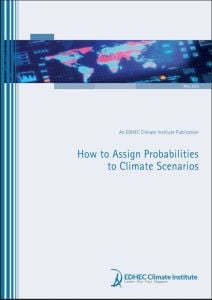

How to Assign Probabilities to Climate Scenarios
The paper “How to Assign Probabilities to Climate Scenarios” by Riccardo Rebonato, Lionel Melin, and Fangyuan Zhang proposes a novel framework for attributing prob ...
Author(s):
Summary:
The paper “How to Assign Probabilities to Climate Scenarios” by Riccardo Rebonato, Lionel Melin, and Fangyuan Zhang proposes a novel framework for attributing probabilities to long-term climate scenarios. This responds to a critical shortcoming in existing scenario analysis tools used in financial regulation and investment strategy, which typically lack a probabilistic dimension. The authors argue that without probabilities, scenarios are limited in their ability to inform risk-adjusted decision-making.
Using a large meta-dataset of 5,905 Social Cost of Carbon (SCC) estimates from 207 academic studies, the research applies two complementary methods: one based on expert assessments of carbon pricing, and the other on a maximum-entropy approach that requires minimal prior assumptions. These approaches produce consistent estimates of the likelihood of different climate outcomes by 2100.
The findings are striking. The probability of limiting global warming to 1.5°C is found to be very low, while the median expected temperature increase is around 2.7°C. Perhaps most notably, the paper estimates a 35–40% chance that global temperatures will exceed 3°C, a level associated with a higher likelihood of irreversible climate tipping points. Furthermore, the analysis suggests that the physical damages resulting from such warming may outweigh the economic costs of a low-carbon transition.
To demonstrate the model’s applicability, the authors align their framework with the structure of the Oxford Economics climate scenarios. They find that more than 90% of the probability mass is allocated to scenarios characterized by limited or delayed abatement. This probabilistic insight allows for a more robust evaluation of transition and physical risks across plausible futures.
The study concludes that integrating probabilities into climate scenario analysis is essential for credible stress testing, regulatory planning, and asset valuation. By offering a tractable and transparent method, the authors contribute a significant tool to the development of climate-resilient financial strategies.
Register to download PDF
Register/Log in| Type : | EDHEC Publication |
|---|---|
| Date : | 22/05/2025 |

